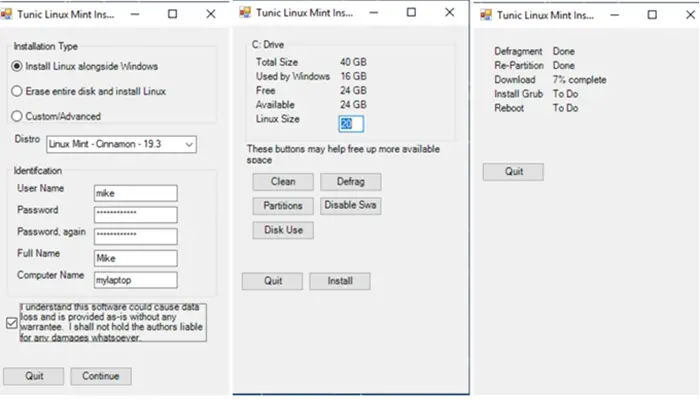Install Linux over or alongside Windows without booting from an external USB drive
The following are the capabilities of Tunic:
Validates your system meets Tunic requirements.Asks all questions at the beginning (unattended install).Offers to convert an MBR disk to UEFI.Offers full disk overwrite or dual boot arrangement.If dual boot, shrink C: volume to make space for Linux.Provides tools to assist with freeing up space for Linux.Provides Linux Mint, Ubuntu, and most official Ubuntu flavors.Downloads the Linux .iso file for you.Installs Grub with Secure Boot support.Calculates Linux equivalent values for your Windows locale and user account.Reboots and runs the Ubiquity installer, automated.If a custom install type is chosen, It will provide Ubuntu’s Ubiquity partition utility GUI.Reboots into your final installed Linux.
The following are the requirements:
Windows 10, 64 bit.Single drive hosting the C: volume.UEFI (supports secure boot).At least 4 GB RAM.At least 15 GB of free disk space on C:.Administrator user permissions.Internet access.AC Wall Power.
The following are the limitations of Tunic that users should be aware of:
Currently, Tunic only installs official flavors of Ubuntu and Linux Mint.No support for other Debian/Ubuntu-based Linux distros, Windows 7/8 and MBR setup.Error handling needs improvement.Due to the nature of what Tunic does, it may show up as a false positive on some malware scans.
Using Tunic software to install Linux over Windows
Follow the instructions below to run the Tunic software and install Linux over or alongside Windows without booting from an external USB drive. Caution: This software could inadvertently and permanently destroy all data, leave a computer unbootable, or otherwise leave a computer in an undesirable state.
Before you start, make sure to backup up an image of your entire disk(s). Tunic does not assist with full disk backup.Close all other running applications.Download and run the latest Tunic executable file.Once you have downloaded the Tunic software, double-click it to launch the installer.You’ll be presented with a GUI which is pretty straight-forward as you can see from the lead-in image above.Next, make your desired selections.Select the Install button at the final screen to run the process. It may take a long time.Once done, enjoy your newly installed Linux distro.
Let us know in the comments section below if you used Tunic software and what your experience was like. Read: How to uninstall Linux in Windows 10 Dual Boot setup.

